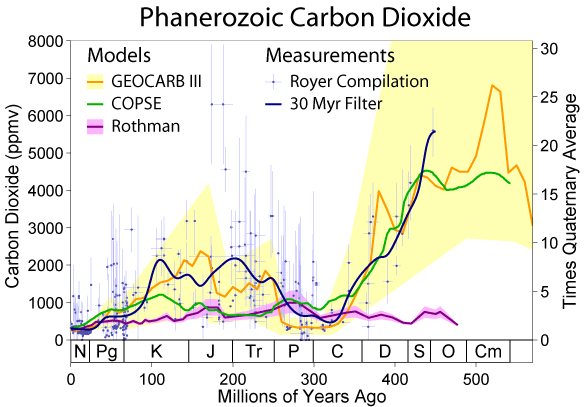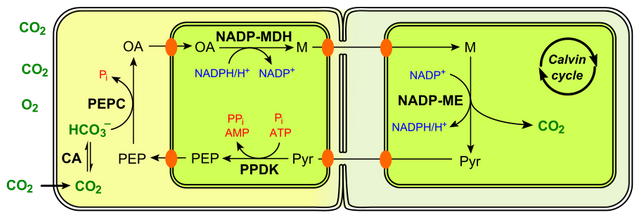C4 Photosynthesis
Background
To understand the driving force for the evolution of C4 photosynthesis in plants it is necessary to appreciate the problems posed by photorespiration for C3 plants ... a problem that becomes more severe as atmospheric CO2 levels decline, as temperature rises, and when water deficits occur. These problems have been discussed extensively in my last 3 posts (Photorespiration - Prelude, Photorespiration - Biochemistry, Photorespiration - Metabolic Engineering) and stem from the fact that O2 competes with CO2 at the catalytic site of the enzyme ribulose-1,5-bisphosphate carboxylase/oxygenase (RuBisCO) that catalyzes the first step of carbon fixation in C3 plants (The Calvin Cycle of C3 Photosynthesis).
Atmospheric CO2, Temperature and the Evolution of C4 Photosynthesis
Angiosperms (flowering plants) with C3 photosynthesis evolved sometime between 140 and 200 million years ago during the age of the dinosaurs (the Jurassic period (J)). Reconstructions of atmospheric CO2 levels using different methods have yielded substantial differences in their estimates of its concentrations. Nevertheless, most methods agree that CO2 levels in the atmosphere during the Jurassic period were several times greater than today, suggesting that photorespiration would likely not have been much of a problem for C3 angiosperms during the early phases of their evolution (Carbon dioxide in Earth's atmosphere - Wikipedia).

Changes in carbon dioxide during the Phanerozoic (the last 542 million years). Image Source:
However, reconstructions of CO2 levels during the last 40 million years (Zhang et al. (2013)) reveal a sharp drop in CO2 levels from about 1000 - 1200 ppm to as low as 200 - 300 ppm during the Oligocene period (34 - 23 million years ago). These low atmospheric levels of CO2 persisted throughout the Miocene (23 - 5 million years ago) and into the Pleistocene (Zhang et al. (2013)), "the geological epoch which lasted from about 2.6 million years ago to 11,700 years ago and spanning the world's most recent period of repeated glaciations" (Pleistocene - Wikipedia).
The last 400,000 years of atmospheric CO2 measurements have shown CO2 levels oscillating between 180 ppm and about 270 ppm during repeated ice age cycles, with a sharp rise in CO2 during the last 150 years due to human activities and burning of fossil fuels.

CO2 concentrations over the last 400,000 years. Image Source:
These low levels of CO2, beginning about 34 million years ago and persisting until 150 years ago have posed severe problems for C3 angiosperms due to accelerated photorespiration and loss of productivity.
During the Oligocene and Miocene transition, global average temperatures were several degrees C greater than today (Oligocene - Wikipedia). Because photorespiration is accelerated at high leaf temperatures (the solubility of CO2 in water decreases more dramatically than the solubility of O2 as temperature rises), this further exacerbated the problem for C3 plants (Christin et al. (2008)).

Global average temperature estimates for the last 540 million years. Image Source:
It is likely that during the time period 34 to 14 million years ago, when high temperature and low CO2 were combined, that C4 photosynthesis first evolved.
So what is C4 photosynthesis?
In essence C4 photosynthesis is a variant of C3 photosynthesis in which the first product of CO2 fixation is a 4-carbon compound instead of a 3-carbon compound. C4 plants first fix CO2 (strictly speaking: HCO3-) by carboxylating a 3-carbon compound called phosphoenolpyruvate (PEP) to form a 4-carbon molecule, oxaloacetate (OA). The enzyme PEP-carboxylase (PEPC) catalyzes this reaction in mesophyll cells of the leaf, assisted by carbonic anhydrase (CA) which catalyzes the reaction: CO2 + H2O ---> H+ + HCO3-.

NADP-ME type C4 pathway. Image Source:
Unlike RuBisCO, O2 does not compete with CO2 at the catalytic site of either carbonic anhydrase or with HCO3- at the catalytic site of PEP-carboxylase, and so these activities are unaffected by the atmospheric CO2:O2 ratio.
Oxaloacetate (OA) produced by PEP carboxylase is converted to the 4-carbon compound malate (M) which is then exported from the mesophyll cells (left in the image above) to specialized bundle-sheath cells surrounding the vascular bundles (right in the image above) of C4 plants. In the bundle-sheath cells, malate is decarboxylated to CO2 and pyruvate. The CO2 released in the bundle-sheath chloroplasts is now several times in excess of the atmospheric CO2, and drives conventional C3 photosynthesis via the carboxylase activity of RuBisCO and the Calvin cycle (see: The Calvin Cycle of C3 Photosynthesis for details).
Basically C4 photosynthesis provides a mechanism for CO2 concentration at the active site of RuBisCO, thereby suppressing photorespiration and associated carbon and energy losses.
Pyruvate (a 3-carbon compound) generated by decarboxylation of malate in the bundle-sheath cells must be returned to the mesophyll cells where it is phosphorylated to regenerate PEP for completion of the cycle. The latter requires investment of energy (ATP) so this pathway does come at an energy cost (there is no free lunch!). Nevertheless, this pathway provides C4 plants with an advantage over conventional C3 photosynthesis especially under warm, dry conditions with low atmospheric CO2 concentrations.
It is notable that the Calvin cycle (and photorespiratory) enzymes are only expressed in the bundle-sheath cells of C4 plants, and not in the mesophyll cells. Moreover, the bundle-sheath cells lack photosystem II (PSII) expression, relying exclusively on photosystem I (PSI) and cyclic electron transport for generation of ATP required for the Calvin cycle (see: Light Reactions of Photosynthesis for details). Because NADP-malic enzyme (NADP-ME) generates NADPH during the formation of pyruvate and CO2 this satisfies the Calvin cycle's requirements for NADPH. By eliminating PSII expression in the bundle-sheath cells, this greatly reduces the production of O2 by water-splitting in the bundle-sheath chloroplasts, again suppressing photorespiration.
Because PEP carboxylase has a much higher affinity for HCO3- than RuBisCO has for CO2, this allows C4 plants to close their stomates to a smaller aperture than C3 plants during water-deficit stress (i.e. drought stress) without impairing carbon fixation. The smaller stomatal aperture in C4 plants restricts water loss via transpiration, and thus C4 plants are more efficient in their water-use. "When grown in the same environment, at 30oC, C3 grasses lose approximately 833 molecules of water per CO2 molecule that is fixed, whereas C4 grasses lose only 277" (C4 carbon fixation - Wikipedia).
Because RuBisCO is only expressed in bundle-sheath cells, this requires much less RuBisCO protein in the C4 leaf versus the conventional C3 leaf. Therefore far less nitrogen is needed to fix CO2. C4 plants are generally considered to be more nitrogen use efficient than C3 plants.
Surprisingly, C4 photosynthesis has evolved over 60 times in the angiosperm lineage during the last 35 million years:
"Of the monocot clades containing C4 plants, the grass (Poaceae) species use the C4 photosynthetic pathway most. Forty-six percent of grasses are C4 and together account for 61% of C4 species. These include the food crops maize, sugar cane, millet, and sorghum. Of the dicot clades containing C4 species, the order Caryophyllales contains the most species. Of the families in the Caryophyllales, the Chenopodiaceae use C4 carbon fixation the most, with 550 out of 1,400 species using it. About 250 of the 1000 species of the related Amaranthaceae also use C4" (C4 carbon fixation - Wikipedia).
The Caryophyllales seem to be quite innovative. Not only are they renowned for their C4 ingenuity, but also their ingenuity in insectivory and associated biochemistry (see Insectivorous Plants - Part 4), and betalain pigment synthesis pathways (Betalains - Unusual Plant Pigments). Spinach (Amaranthaceae, formerly Chenopodiaceae) (Why Did Popeye Consume Spinach?), however, is a conventional C3 plant, with 50% of its leaf protein content devoted to RuBisCO.
Variants of the basic C4 photosynthesis pathway described above have been identified. Certain C4 species (e.g. millet) employ an NAD-ME type C4 pathway in which, instead of shuttling oxaloacetate and pyruvate between mesophyll and bundle-sheath cells, the plants convert these 2-keto acids to amino acids for transport. Thus, oxaloacetate is converted to aspartate for transport, while pyruvate is converted to alanine for transport. This requires operation of aminotransferases working in opposing directions in both the mesophyll and bundle-sheath cells. In the NAD-ME type C4 pathway, oxaloacetate is converted to pyruvate and CO2 via malate in the mitochondrion (see C4 carbon fixation - Wikipedia for details).
In the PEPCK type C4 pathway (found in grass species such as Panicum maximum), the enzyme PEP carboxykinase is used to generate PEP and CO2 from oxoalacetate in the bundle-sheath cells (see C4 carbon fixation - Wikipedia for details).
The evolution of C4 photosynthesis has been the subject of literally hundreds of research papers. I cite several of these articles, with particular emphasis on the more recent literature, in the References section below. The reader is encouraged to consult these articles to verify the information provided above and glean further details of this remarkable process. Evidence is growing that there are intermediary C3-C4 plants species which may literally still be in the process of transitioning from C3 to C4 photosynthesis.
As with photorespiration, plant biologists are tinkering with the genomes of agriculturally important C3 plants to enhance photosynthesis with the goal of increased productivity and yield. Major efforts are currently under way to try to engineer the C3 plant, rice, with C4 photosynthesis (see for example Wang et al. (2017), and Science of C4 Rice).
Yet another form of C4 photosynthesis is known as Crassulacean Acid Metabolism (CAM) and this will be the subject of my next post.
References
Furbank, R.T. Walking the C4 pathway: past, present, and future. J. Exp. Bot. 68: 4057-4066 (2017)
Ludwig, M. Evolution of carbonic anhydrase in C4 plants. Curr. Opin. Plant Biol. 31: 16-22 (2016)
Ludwig, M. The roles of organic acids in C4 photosynthesis. Front. Plant Sci. 7: 647 (2016)
Sage, R.F. Tracking the evolutionary rise of C4 metabolism. J. Exp. Bot. 67: 2919-2222 (2016)
Please feel free to comment or ask questions in the comments section below.
I will try to break the ice. You are writing very in-depth and specialized articles that require and challenge my attention. Challenge accepted :D
Basically the things I have kept after reading are:
Maybe more, but they will sediment in time :P
Thanks again for taking the time!
A tip for engaging more users is to place a separated simple paragraph that will stand out to new users, basically offering them a point to start and engage a discussion without feeling shy :P It happened to me too on my articles in the beginning.
For your other readers:
Geologist Iain Stewart made a BBC TWO documentary a few years ago in which he covered "How to grow a planet", talking about similar topics but not nearly as in depth as @davidrhodes124. I can send you to the general search page and you can watch the documentaries which are pretty easy for a newbie to follow:
https://www.youtube.com/results?search_query=How+to+Grow+a+Planet
Great commentary and suggestions. Thank you for this feedback. I will try to implement your idea of placing a separated simple paragraph that will highlight the main points. Yes, I had seen Iain Stewart's documentaries on BBC .... as I recall he called C4 photosynthesis "turbo-charged" photosynthesis, or something to that effect. I will try to add explanatory animations or videos in future posts. I am relatively new to Steemit (since late February, 2018) and I am still learning the ropes.
I can recommend this video which explains the difference between C3-photosynthesis and C4-photosynthesis and how the latter protects against carbon losses due to photorespiration in hot and dry environments. It also briefly introduces Crassulacean Acid Metabolism (CAM) that I will write about in my next post.
Alternative Pathways of carbon fixation: C4 and CAM plants
by Craig Savage
Published on Jan 13, 2012